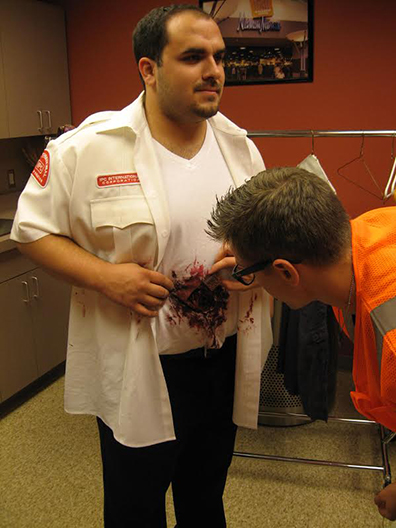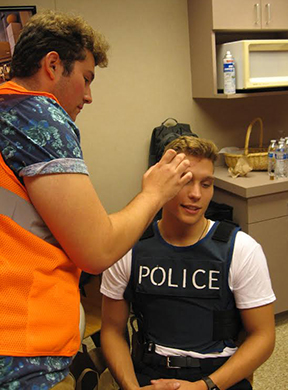by Gillian Ellis

On Sunday, September 21 some of our theatre students gave a performance unseen by anyone except 300 first responders from local and federal agencies. For the officers involved, it was a kind of rehearsal for an emergency event that everyone hopes will never happen.
Our students were part of a first responder training exercise: A disaster drill to prepare for the unthinkable, an attack by a gunman on a local shopping mall.
Last winter the Oakland University Police Department approached
Leslie Littell for help. Leslie is a special lecturer in theatre who teaches costume design. She said, “The initial contact came through the OUPD because we had helped them four or five years ago with an on-campus shooter training event.”
As the planning process moved forward, Leslie was provided with a list of wound scenarios the officers wanted to deal with. For example, they wanted three wounds they could apply a tourniquet to. Leslie recruited four students interested in special effects (SFX) production to research and produce the wounds. Over the summer
Richard McClure,
Nicolas Mandziara,
Ellie Teucke and
Craig Horning, all OU theatre design and technology students, researched what kind of gunshots would produce the required kind of wounds. They then worked to fabricate SFX prosthetics that would simulate each wound.
The prosthetics are first molded in clay, then cast in plaster, and finally created in latex and painted. The process of creating these latex SFX wounds is called moulage when used in a criminal justice or medical setting.
Richard McClure recently transferred to the theatre program from the OU biology department, bringing with him, perhaps, a special interest in the human body. But he said, “This was a whole new learning experience for me. My favorite part was learning to use liquid latex to create very realistic bullet wounds, which was just so thrilling. As for the rest of the project, I was honored to be able to work this event because . . . it was a chance to help the community in a very unique way. Then during the play-out of the shootings, just to stand on the sidelines and watch this event come together, as something I had helped create, was so very rewarding.”
Leslie Littell said, “For students interested in SFX as a career, it’s great to see some real life applications outside those in theatre and film.” She noted that these kinds of effects are advanced skills that are not usually taught in class, which meant the group had to workshop the project.
OU also provided actors to play victims and other characters. Leslie said, “We created back stories for the actors, so they could perform in a full way.”
On the evening of the event, Great Lakes Crossing Shopping Mall, in Auburn Hills, closed one hour early to allow the preparedness training plenty of time to run its course. Most of the action played out in the food court.
Josh Williams, another design and tech student, worked on sound effects, producing alarms and gunshots. OU theatre students donned their make-up and took their place in the scenario.
 Colby Orton
Colby Orton played a wounded police officer and
Mitch McFee a wounded mall security guard.
Anna Marck,
Garrett Markgraf and
Katrina Rene Miller played victims, while
Jillian Hoffman assumed the role of an hysterical witness.
Jennifer Bieganowski and
Andrew Wernette, both OU communications majors, played news reporters. Professor
Michael Gillespie, who is a retired OU theatre faculty member and Professor
Carolyn Gillespie, who is a retired University of Michigan - Flint faculty member, also played victims. Leslie Littell coordinated all the OU teams. Additional victims were played by students from Avondale and Waterford High Schools.
This was a large-scale event. In addition to the OUPD, the FBI, the Department of Homeland Security, the Auburn Hills Police Department and the Lake Angelus Police Department took part in the training. Fox News covered the story
and you can see that here.
For all the theatre students this was invaluable professional experience, but it was also a major undertaking, especially for the design and tech students who each spent between ten and twelve hours of their summer on their projects. All the OU students volunteered their time, as did Leslie Littell, but all were proud to work with the first responders and to have this opportunity to use their skills to provide a service to the community.
And their contribution was duly noted.
Lieutenant Terry Ross of the Oakland University Police said, “Leslie and her team of students from Oakland provided a valuable contribution to the entire exercise. They volunteered their time and used their talent with moulage so that officers had a much more realistic experience.”
Below you can read the notes that Anna Marck made right after the event. They provide an interesting and hard to find firsthand account of the impact this kind of simulation has on participants.
“Though I've been acting for ten years, I've never done anything like this. This shooter simulation dealt with events that could actually happen... In places they could actually happen... With people they could actually happen to. Because of the realness of the setup, sometimes there was a challenge deciphering fact from fiction. There was no script. Therefore, people didn't know if I was speaking as myself (Anna) or as my character (a victim who fell, broke her ankle and impaled her hand in some glass). As I struggled to stand, limping out of the building, I said to the emergency medical response team: "Will you look at my ankle? I rolled and landed on it and I think I really hurt it," they looked at me, questioningly, and said, ‘Wait. For real?’ I slowly smiled at them and said, ‘No.’
“For the majority of the simulation, I was lying on the ground waiting for things to happen. When the initial gunshots fired and I heard the screams of my fellow actors, I was brought to tears, looking at the gash on my hand covered in stage blood. I tried to make this situation as real as possible inside my head, creating fear of being killed, knowing I couldn't move, knowing there was a shooter in the building, terrified that I could die right here on the food court floor (what a horrible thought). There were moments that I got very emotional, and my view was of tears and splatters of stage blood on the ground. There were other moments when I was pulled out of the 'simulation' anytime someone walked by who wasn't directly related to creating the mood of the event.
“Later, the police team called to me: 'Pink shirt! Pink shirt!' I was confused because I was wearing an orange jacket [over my pink shirt]. Still, I turned and saw them motioning me to cross the open aisle way toward them. With my injuries, I could only crawl. So I crawled across to them. They asked me if I could stand. ‘Maybe if someone helps me up.’ One of them did, pointed toward the exit. ‘There's an exit over there,’ he said. And I limped out of the building. I was a little surprised to have not been offered more help. But I have to admit, I did feel such relief when I exited the building and was reunited with my fellow OU actors who I had been away from for over an hour. Even in a simulated tragic event, there's nothing like seeing familiar faces when it's over with. Overall, I think it was a great experience for all involved.”
Photos:
Upper left: Nicolas Mandziara applies the finishing touches to a wound on Mitch McFee.
Lower right: Craig Horning applies make-up to Colby Orton
Photos by Leslie Littell

 On Sunday, September 21 some of our theatre students gave a performance unseen by anyone except 300 first responders from local and federal agencies. For the officers involved, it was a kind of rehearsal for an emergency event that everyone hopes will never happen.
On Sunday, September 21 some of our theatre students gave a performance unseen by anyone except 300 first responders from local and federal agencies. For the officers involved, it was a kind of rehearsal for an emergency event that everyone hopes will never happen. Colby Orton played a wounded police officer and Mitch McFee a wounded mall security guard. Anna Marck, Garrett Markgraf and Katrina Rene Miller played victims, while Jillian Hoffman assumed the role of an hysterical witness. Jennifer Bieganowski and Andrew Wernette, both OU communications majors, played news reporters. Professor Michael Gillespie, who is a retired OU theatre faculty member and Professor Carolyn Gillespie, who is a retired University of Michigan - Flint faculty member, also played victims. Leslie Littell coordinated all the OU teams. Additional victims were played by students from Avondale and Waterford High Schools.
Colby Orton played a wounded police officer and Mitch McFee a wounded mall security guard. Anna Marck, Garrett Markgraf and Katrina Rene Miller played victims, while Jillian Hoffman assumed the role of an hysterical witness. Jennifer Bieganowski and Andrew Wernette, both OU communications majors, played news reporters. Professor Michael Gillespie, who is a retired OU theatre faculty member and Professor Carolyn Gillespie, who is a retired University of Michigan - Flint faculty member, also played victims. Leslie Littell coordinated all the OU teams. Additional victims were played by students from Avondale and Waterford High Schools.